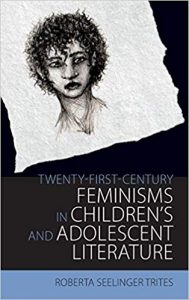Modern feminism is more than the status of women in a society. In the United States, feminism has evolved as a reflection of the issues that suppress equality for all.

Roberta Trites is a Distinguished Professor at Illinois State and is currently serving as an interim department chair in the College of Business.
Illinois State University’s Distinguished Professor of English Roberta Trites explores the newest ideas in feminist writing as seen through the characters in young adult literature (YA). Trites, the author of Twenty-First-Century Feminisms in Children’s and Adolescent Literature—which comes out in paperback this summer—notes that feminism goes deeper than female empowerment and power structures.
“It’s still important that a young, female protagonist be empowered,” said Trites, “but there’s much more to be explored than just social power.”
Coming under the heading of “material feminism,” feminist writings are now working to understand the relationship between people and their interaction with the material world. “The idea is that every person, every object, has some form of agency on us—some sort of effect—and we are changed through perceptual processes,” said Trites. “The material feminists believe we must pay attention to the material world in order to understand gendering.”
It’s important to remember that women can have social power, but it can be undermined, whether financially or through objectification. — Roberta Trites
In Twenty-First-Century Feminism, Trites looks to YA novels to touch on the cornerstones of material feminism, including critical race theory, neoliberalism, and ecofeminism.
Connected to the concerns of devastation due to climate change, ecofeminism explores how female bodies and land can be exploited in the same way. “There’s a mythology in American history of men owning the land, and conquering the land, cultivating the land, and tilling and sowing the land,” said Trites. “Women, who are equated with the body, can suffer the same treatment with the idea they can be owned and exploited.”
Ecofeminism is on display in the 2013 dystopian novel Orleans by Sherri Smith, said Trites, which focuses on a female protagonist in a hurricane-destroyed New Orleans. “In Orleans, the main character Fen is a teenage girl, but there is nothing romantic with the male lead. They create a partnership, and take care of one another to achieve their goal,” said Trites.

Cover of the book Twenty-First-Century Feminisms in Children’s and Adolescent Literature by Roberts Trites
Trites looked to a vastly different novel to explain material feminism’s jab at putting profit over people. “Libba Bray’s Beauty Queens is a wickedly funny look at neoliberalism through the eyes of beauty contestants stranded on an island,” she said. “It’s important to remember that women can have social power, but it can be undermined, whether financially or through objectification.”
Material feminism can be seen as the next step in feminist studies. Scholars tended to view feminism in the United States as coming in “waves.” The first wave in the late 19th and early 20th centuries is characterized by the push for women’s property and suffrage rights. The second wave of the 1950s-1970s centered on female empowerment and equality. The third wave—from the 1990s to the early 2000s—focused on community. “Feminist scholars and authors began to examine whether a woman has a voice and a choice within a community. Is she even allowed to have a community of support?” asked Trites.
YA works tend to reflect waves of feminism in varying degrees, noted Trites. Looking at the popular Hunger Games series by Suzanne Collins (2008-2011), the female lead, Katniss Everdeen, is strong, but still falls short in some areas of third-wave feminism. “Katniss is an empowered character, but she only has voice when she is seen as embodying the symbolic Mockingjay,” said Trites. “And at the end of the books, she has no female community.” The series’ other main fellow character, Peeta Mellark defers all power to Katniss. “He’s a classic third-wave romantic hero who is very much of the mind-set, ‘It’s all about you, baby,’” said Trites. “Peeta is so self-abdicating that he makes it all about her needs, her life, and her body being more important than his. That’s not equality if one person is calling all the shots.”
Material feminism in YA still examines relationships and empowerment, but views the characters as complete beings, rejecting the idea that the brain and body are separate. “We can’t have a brain without a body. We can’t have a body without a brain,” said Trites, who added sexist roles are often entrenched in the separation. “Throughout much of Western history, women have been equated with the body and men with the mind.”
The need for female empowerment never goes away. Sadly, it’s never out of style. — Roberta Trites
Trites hopes instructors of YA literature will take the ideas of material feminism to infuse more discussions into their classroom, but advises teachers to look beyond lumping novels into categories. “Teachers need to think in a range, beyond asking ‘Is this work feminist? Is it sexist?’” said Trites. “It’s not a binary. We can look at many different aspects of how we assess something as having elements of feminism.”
Even if a book does not uphold all of the values of current ideas of feminism, Trites believes YA can provide an outlet that offers young women an alternative to sexism. “The need for female empowerment never goes away. Sadly, it’s never out of style,” she said.

